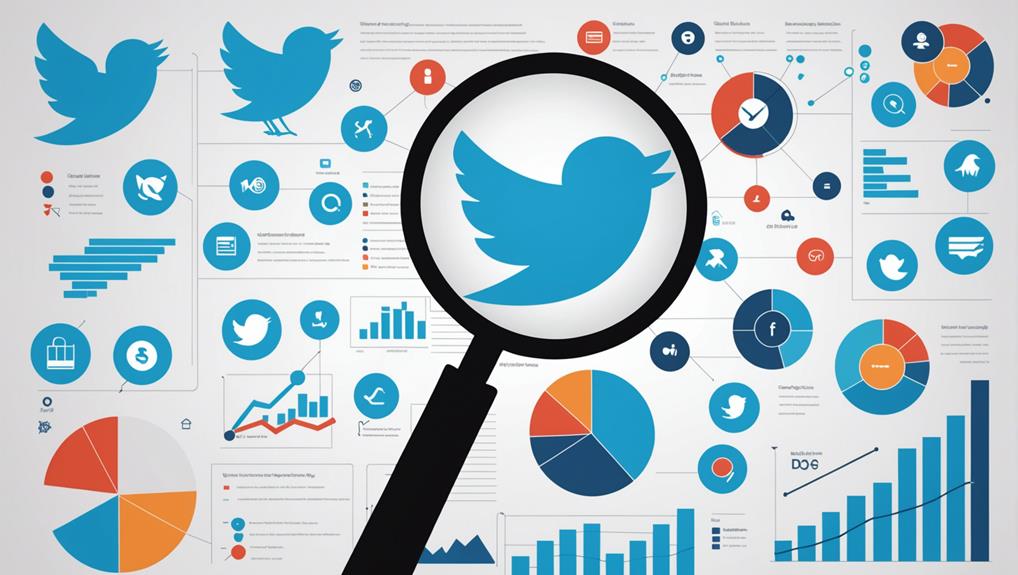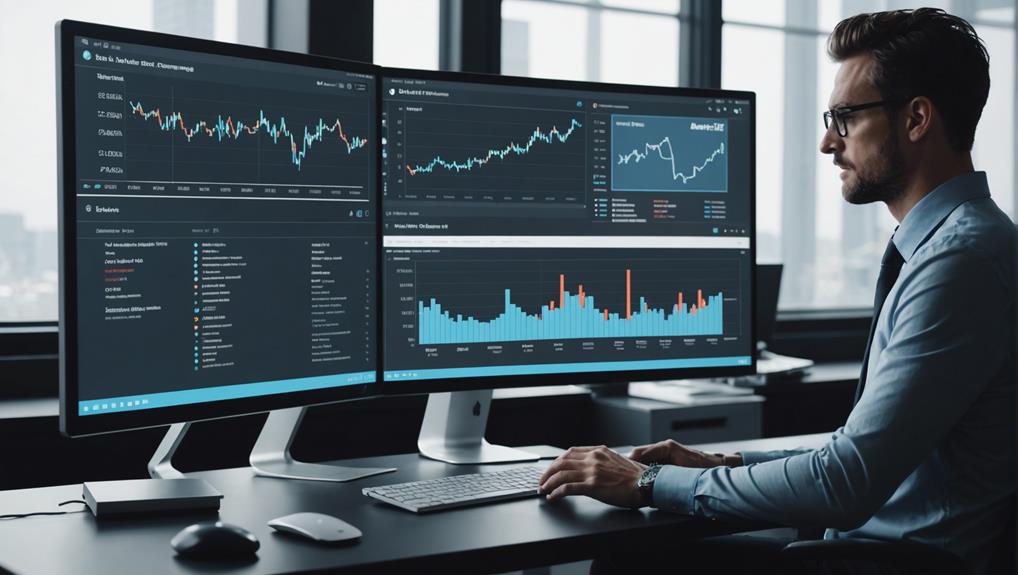To craft an effective Twitter content strategy, focus on key analytics. Measure engagement rate, track impressions, and monitor follower growth to assess content success. Optimize posting by targeting peak engagement hours for improved visibility. Understanding audience demographics and interests can refine content, enhancing relevance. Competitor analysis offers insights into successful strategies and potential gaps. Experiment with diverse content types and interactive formats to boost engagement. Review hashtag performance to optimize reach. Regular analysis and adjustment allow content to stay relevant, adapting to emerging trends. Master these strategies to effectively leverage Twitter’s potent analytics for growth and engagement.
Key Takeaways
- Regularly analyze engagement rate to identify trends and adjust content strategies for better audience interaction.
- Utilize analytics tools like Hootsuite for competitor insights and to track engagement across tweets.
- Experiment with diverse content types and interactive formats to enhance audience engagement and reach.
- Monitor hashtag performance to optimize strategies and maximize content visibility and engagement.
- Analyze audience demographics and peak engagement hours to tailor content and posting times effectively.
Understand Key Metrics
In the domain of social media strategy, the understanding of key metrics serves as the cornerstone for crafting effective Twitter content that resonates with audiences. A vital component is the Engagement Rate, which quantifies interactions such as likes, retweets, and comments as a percentage of total Impressions. This metric provides a clear picture of how well a post resonates with its audience, offering insights into the types of content that stimulate engagement.
High engagement rates typically indicate compelling content that not only reaches but captivates its intended audience.
Impressions, on the other hand, measure the frequency with which tweets are viewed, offering a lens into the content’s visibility and reach. By analyzing impressions, one can assess whether the content is being seen by a wide audience or is limited in its outreach. However, visibility alone is insufficient without engagement, highlighting the importance of a balanced strategy.
Lastly, monitoring Follower Growth is essential for measuring the long-term impact of content strategies. By tracking increases or decreases in followers, marketers can evaluate the success of their efforts in attracting and retaining an audience, which is fundamental for sustained growth and influence on the platform.
Optimize Posting Times
Understanding key metrics sets the foundation for creating impactful content, yet timing plays a significant role in maximizing engagement. Optimizing posting times is essential for aligning content delivery with peak audience activity. Analyzing audience activity patterns reveals that weekday engagement typically peaks between 10-11 am and 6-7 pm. These windows represent strategic opportunities to enhance visibility and interaction.
Regularly monitoring engagement metrics through Twitter’s analytics tools allows users to tailor their posting schedules effectively. By examining past tweet performance, one can identify which time slots have historically yielded the highest engagement. This data-driven approach guarantees that content is shared when the audience is most receptive, thereby maximizing reach and interaction.
A/B testing is another valuable strategy in optimizing posting times. By experimenting with different time slots and comparing engagement outcomes, users can refine their strategies to discover what works best for their specific audience. This iterative process, grounded in data analysis, leads to informed decision-making and improved content strategies.
Consistency in posting during identified peak times amplifies audience interaction, enhancing overall engagement metrics. By integrating these insights into your Twitter strategy, you can effectively leverage timing to boost visibility and impact.
Leverage Audience Insights
Frequently, the most successful Twitter content strategies are those that leverage audience insights to foster deeper engagement and relevance. Through the careful analysis of demographic data from Twitter Analytics, marketers can tailor content to specific segments, thereby enhancing its relevance and appeal.
Understanding the interests and behaviors of your audience allows for the creation of content themes that resonate more effectively, leading to increased engagement.
Moreover, examining follower activity times through analytics is a powerful tactic. By aligning posting schedules with peak engagement hours, brands can greatly boost their visibility and interaction rates.
Segmenting followers by their engagement levels further refines this approach, enabling the identification of highly active users. These insights facilitate the development of personalized content strategies that nurture loyalty and foster a sense of community.
- Insightful Content Creation: Craft messages that resonate by understanding audience interests.
- Optimized Timing: Post during peak engagement hours to maximize visibility.
- Personalized Strategies: Engage loyal followers with tailored content.
- Continuous Refinement: Use audience interactions to adapt to evolving trends.
Analyze Competitor Strategies
In the competitive landscape of Twitter, monitoring your competitors’ engagement metrics such as likes, retweets, and comments is essential for benchmarking your performance and identifying areas where your strategy may fall short.
By analyzing these metrics, you can uncover strategy gaps and craft content that better resonates with your target audience.
Additionally, comparing your performance to competitors can offer insights into successful tactics, helping you refine your approach to boost engagement and enhance your brand’s online presence.
Monitor Competitor Engagement
Analyzing competitor engagement metrics is a crucial step in refining your Twitter content strategy. By regularly evaluating likes, retweets, and comments on competitors’ posts, you can benchmark your performance and identify effective content strategies within your niche.
Utilizing analytics tools like Hootsuite or Sprout Social enables you to gather insights on competitors’ top-performing tweets, aiding in shaping your content strategy based on proven success.
To effectively monitor competitor engagement, consider the following steps:
- Observe Content Types: Identify which content, such as visuals or polls, garners high engagement. This insight can guide your content creation to enhance interaction.
- Track Posting Patterns: Analyze the frequency and timing of competitors’ posts to discover ideal schedules that align with audience activity, maximizing your content’s visibility.
- Benchmark Performance: Compare your engagement metrics with those of competitors to understand where you stand and what improvements can be made.
- Leverage Analytics Tools: Use platforms like Hootsuite to extract detailed competitor insights, refining your strategy with data-driven decisions.
Identify Strategy Gaps
Building on the insights gained from monitoring competitor engagement, it’s essential to identify strategic gaps that can be leveraged to enhance your Twitter content approach. By systematically analyzing competitors’ engagement metrics—such as likes, retweets, and comments—you can pinpoint areas where your content strategy based efforts may fall short. This analysis offers a data-driven perspective on how competitors successfully engage their audiences and highlights potential improvements for your strategy.
Explore the frequency and timing of competitor tweets to determine if there are ideal posting windows that you have yet to capitalize on. This can reveal gaps in your content schedule, guiding adjustments that maximize audience interaction during peak times.
In addition, assess the content types that competitors frequently post, identifying themes or formats that consistently yield higher engagement metrics. This can inspire innovative content strategies tailored to your target audience.
Utilize tools like Hootsuite or Sprout Social to track long-term trends in competitor performance, such as follower growth and interaction patterns. Moreover, analyze competitors’ hashtag usage to discern which tags enhance visibility and engagement, refining your own hashtag strategy.
Benchmark Against Competitors
Effective benchmarking against competitors is an essential component of refining your Twitter content strategy. By analyzing competitors’ engagement metrics, such as likes, retweets, and comments, you can set valuable benchmarks for your own content performance. This analysis not only highlights areas for improvement but also provides a clear direction for enhancing your engagement metrics.
Monitoring the types of content that competitors post, including visuals and interactive formats, allows for the identification of innovative strategies that resonate with your target audience. Meanwhile, tracking the posting frequency and timing of competitors’ tweets can reveal ideal periods for maximizing your content’s visibility and engagement.
In addition, evaluating competitors’ use of hashtags and trending topics can greatly enhance discoverability and audience reach, thereby informing your hashtag strategy. Regular assessment of competitors’ follower growth patterns can uncover successful tactics for audience engagement and retention, allowing you to adapt your strategies accordingly.
Consider these insights to drive your competitive edge:
- Increased audience engagement: Adapt content based on successful competitor practices.
- Enhanced visibility: Identify ideal posting times.
- Improved hashtag strategy: Utilize trending topics effectively.
- Innovative content creation: Draw inspiration from competitor content types.
These strategies, rooted in data, can transform your Twitter presence.
Experiment With Content Types
To optimize engagement on Twitter, it is essential to diversify visual elements by incorporating images, videos, and user-generated content, as these formats can greatly increase viewership by up to 94%.
Testing interactive formats like polls and threads can further enhance user interaction, with data indicating that threads can boost engagement by 13%.
Diversify Visual Elements
Consistently incorporating a variety of visual elements into your Twitter strategy is essential for maximizing audience engagement. By leveraging engaging content such as images, videos, and infographics, brands can greatly boost their interaction rates.
Data shows that incorporating visual content can increase engagement rates by up to 150% compared to text-only tweets, highlighting its critical role in capturing audience attention. Furthermore, consistent branding across these diverse formats not only strengthens brand recognition but also sustains audience interest over time.
To effectively harness the power of visual elements, consider these strategies:
- Authentic Imagery: Use images that resonate emotionally with your audience, evoking genuine responses and connection.
- Dynamic Videos: Employ short, impactful videos that succinctly convey your message, increasing the likelihood of shares and retweets.
- Informative Infographics: Transform complex data into visually appealing infographics, making information digestible and engaging.
- User-Generated Content: Showcase audience contributions to build community loyalty and encourage further interaction.
Through strategic diversification of visual content, brands can not only enhance their audience engagement but also foster a deeper connection with their followers.
Analyzing performance metrics of these diverse elements will further enable continual optimization and effectiveness in your Twitter content strategy.
Test Interactive Formats
Building on the power of diverse visual elements, exploring interactive formats can further enhance your Twitter content strategy.
Interactive formats like polls and questions are key in driving higher engagement rates. These formats prompt direct participation from followers, leading to increased interaction and retention. By incorporating user-generated content, you not only foster a sense of community but also boost the authenticity of your posts, making them more relatable and engaging for the audience.
A/B testing different interactive elements, such as altering the wording or formats of polls, is essential for gaining data-driven insights into what resonates best with your audience. This approach allows for more targeted content strategies, ensuring that your posts are precisely tailored to audience preferences.
Additionally, visual content combined with interactive components often results in higher engagement levels; tweets with images or videos generally receive 150% more retweets than those without, underscoring the effectiveness of this strategy.
Analyze Engagement Patterns
Analyzing engagement patterns is crucial for understanding what content types resonate most effectively with your Twitter audience. By experimenting with different content types such as visuals, polls, and informative threads, you can uncover the formats that notably boost engagement metrics.
Visual content, for instance, can improve engagement by up to 150% compared to text-only tweets. Tracking likes, retweets, and replies across various tweet formats allows for a data-driven content strategy that aligns with audience insights.
Utilizing A/B testing for tweet elements—including wording, images, and formats—provides deeper insights into audience preferences. This analytical approach guarantees a more tailored content strategy, potentially enhancing interaction rates.
Additionally, monitoring engagement metrics over time helps in identifying peak engagement hours. Adjusting your posting schedule based on these insights can optimize visibility and interaction.
Regularly reviewing audience insights and engagement patterns facilitates the development of targeted content themes. This process boosts relevance, driving higher engagement rates among specific demographic segments.
Remember:
- Visuals ignite emotions and increase engagement.
- Polls invite participation, fostering interaction.
- Threads provide depth, encouraging sustained interest.
- Timing matters; capture peak interaction periods.
Incorporating these data-driven strategies can notably enhance your Twitter engagement.
Utilize Hashtag Performance
To effectively harness the power of hashtags on Twitter, it is essential to scrutinize their performance through detailed analysis of engagement metrics such as likes and retweets. By closely monitoring hashtag performance, you can determine which hashtags generate the highest levels of visibility and engagement for your content.
This analysis allows you to identify the specific tags that resonate most with your audience, leading to a more targeted and impactful hashtag strategy.
Utilizing Twitter’s analytics tools, you can compare the reach and engagement of tweets using various hashtags. This comparison not only highlights the most effective hashtags for your target audience but also reveals trends in audience interaction and preferences.
By tracking the performance of trending hashtags, you can leverage current events to notably boost your content’s visibility and engagement.
Experimenting with a mix of popular and niche hashtags can optimize your reach, simultaneously tapping into broad audiences and specific communities aligned with your brand.
This strategic approach enables you to maintain relevance and enhance your content’s discoverability. Regularly updating your hashtag strategy based on analytics guarantees that your content remains engaging and avoids the pitfalls of using outdated hashtags.
Review and Adjust Regularly
Consistently reviewing and adjusting your Twitter content strategy is essential for maintaining its effectiveness. By regularly analyzing audience engagement, you can identify emerging trends, ensuring your approach remains aligned with user preferences.
Key to this process is the evaluation of engagement metrics such as likes, retweets, and comments. These indicators not only pinpoint successful content types but also guide future posts to enhance interaction rates.
Setting measurable goals and tracking them diligently against these metrics allows for continuous improvement. By doing so, you can fine-tune your content strategy to better meet the evolving needs of your audience.
Consider the following benefits of regular review and adjustment:
- Enhanced Connection: Understand what your audience values and tailor content to resonate more deeply.
- Strategic Timing: Optimize posting schedules based on audience activity patterns, maximizing visibility during peak times.
- Data-Driven Innovation: Use A/B testing to experiment with content formats and topics, refining your approach based on concrete data.
- Proactive Adaptation: Stay ahead of trends, ensuring your content remains relevant and impactful.
Ultimately, a disciplined approach to reviewing and adjusting your Twitter strategy will lead to more meaningful engagement with your audience and sustained success.
Frequently Asked Questions
How Can I Measure the ROI of My Twitter Campaigns?
To measure the ROI of Twitter campaigns, utilize campaign performance metrics, implement conversion tracking methods, and conduct engagement rate analysis. These data-driven approaches provide insights into the effectiveness and financial return of social media marketing efforts.
What Tools Are Best for Tracking Twitter Analytics?
To effectively track Twitter analytics, consider using Twitter Metrics Tools like Hootsuite, Sprout Social, or Buffer. These platforms provide insightful data on Engagement Rate and Follower Growth, enabling data-driven decisions to enhance your social media strategy.
How Do I Identify My Target Audience on Twitter?
To identify your target audience on Twitter, analyze demographic insights to understand key characteristics. Evaluate audience engagement metrics to assess interaction levels and study content preferences to tailor strategies that resonate with users’ interests and behaviors.
What Is the Role of Twitter Ads in Content Strategy?
Twitter Ads play an essential role in content strategy by leveraging diverse Twitter Ad Types, utilizing precise Targeting Options to reach specific audiences, and analyzing Ad Performance metrics to optimize engagement, ensuring effective resource allocation and strategic goal achievement.
How Can I Use Twitter Analytics to Improve Brand Awareness?
Leveraging Twitter analytics can enhance brand awareness by analyzing engagement metrics to refine content strategies. Utilizing audience insights enables content optimization, ensuring relevant and engaging material that resonates with target demographics, ultimately strengthening brand visibility and recognition.
Conclusion
A robust Twitter content strategy necessitates a thorough understanding of key metrics, ideal posting times, and audience insights. By analyzing competitor strategies, experimenting with diverse content types, and leveraging hashtag performance, organizations can enhance their Twitter presence. Regular review and adjustment of strategies are essential to align with evolving trends and audience preferences. Employing data-driven insights guarantees a dynamic and responsive approach, fostering increased engagement and maximizing the effectiveness of Twitter as a communication platform.




